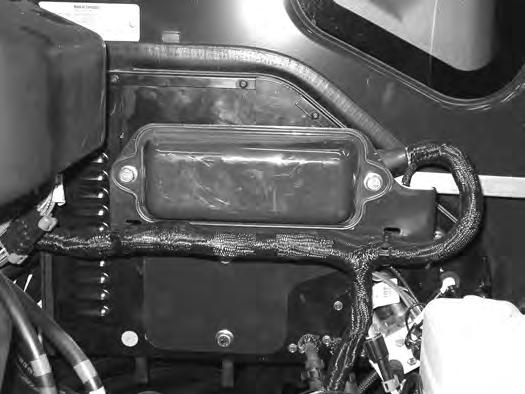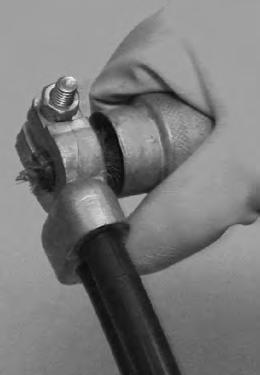
2 minute read
ELECTRICAL SYSTEM
Description
Figure 304
The excavator has a 12 volt, negative ground electrical system. The electrical system is protected by fuses (Item 1) [Figure 304] located under the right side cover of the excavator. The fuses will protect the electrical system when there is an electrical overload. The reason for the overload must be found and corrected before starting the engine again.
The battery cables must be clean and tight. Check the electrolyte level in the battery. Add distilled water as needed. Remove acid or corrosion from the battery and cables with a sodium bicarbonate and water solution.
Put Battery Saver P/N 6664458 or grease on the battery terminals and cable ends to prevent corrosion.
Warning
AVOID INJURY OR DEATH
Batteries contain acid which burns eyes and skin on contact. Wear goggles, protective clothing and rubber gloves to keep acid off body.
In case of acid contact, wash immediately with water. In case of eye contact get prompt medical attention and wash eye with clean, cool water for at least 15 minutes.
If electrolyte is taken internally drink large quantities of water or milk! DO NOT induce vomiting. Get prompt medical attention.
W-2065-0807
Fuse And Relay Location / Identification
A decal is inside the fuse cover to show location and amp ratings.
Remove the cover to check or replace the fuses and relays.
The location and sizes are shown in [Figure 305]
Always replace fuses using the same type and capacity.y
ELECTRICAL SYSTEM (CONT’D)

Fuse And Relay Location / Identification (Cont’d)
Figure 305
ELECTRICAL SYSTEM (CONT’D)
Battery Maintenance
See the SERVICE SCHEDULE for the correct service interval. (See SERVICE SCHEDULE on Page 137.)
The Bobcat brand battery supplied with your machine is sealed and does not require watering. Proper charging and storage are important to maximize the life of all batteries.
Warning
Avoid Injury Or Death
Batteries contain acid which burns eyes and skin on contact. Wear goggles, protective clothing and rubber gloves to keep acid off body.
In case of acid contact, wash immediately with water. In case of eye contact get prompt medical attention and wash eye with clean, cool water for at least 15 minutes.
If electrolyte is taken internally drink large quantities of water or milk! DO NOT induce vomiting. Get prompt medical attention.
W-2065-0807
Maintaining Battery Charge Level
Simple steps for reliability and long battery life:
•Keep battery posts and terminals clean [Figure 306].

•Keep terminals tight.
•Remove corrosion from battery and terminals with sodium bicarbonate (baking soda) and water solution.
•Put Bobcat Battery Saver or grease on the battery terminals and cable ends to prevent corrosion.
•Operate the machine for at least 15 minutes to recover from the battery drain caused by engine start up whenever practical.
•Maintain the battery charge level. This is a key factor for long battery life.
•Charge a severely discharged battery with a battery charger instead of relying on the machine charging system. (See Battery Charging on Page 161.)
•Check the battery state of charge every 30 days on machines that are not frequently used. (See Battery Testing on Page 161.)
All batteries will self-discharge over time. This machine has features that require battery power even when the machine is not being used. Use of a quality battery maintainer is highly recommended to ensure that your machine is ready to start when you need it and avoid costly battery replacement.
Battery Maintainers
Use a good quality battery maintainer to keep the battery above 12.4 volts for machines that are not frequently used. Batteries below 12.4 volts must first be charged using a battery charger. Solar maintainers should have a minimum capacity of 10 watts to be effective.

Battery Service During Machine Storage
Remove the battery if storing the machine for an extended period of time. Fully charge the battery. Store the battery in a cool dry place above freezing and boost charge periodically. If battery removal is not desired, a good quality battery maintainer must be used to compensate for battery self-discharge and parasitic loads from machine controllers, accessories, and features such as connected machine intelligence.







